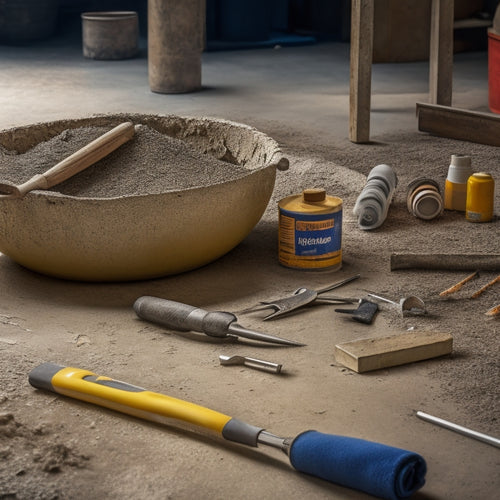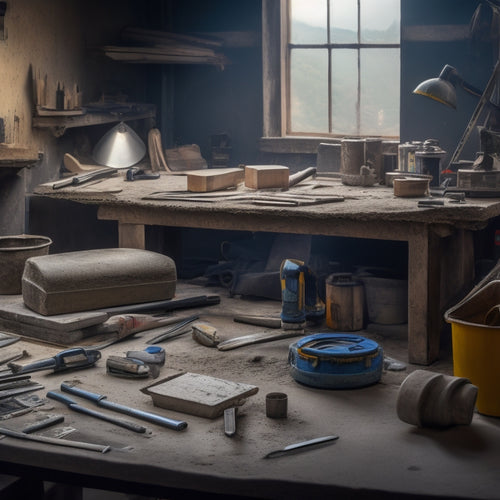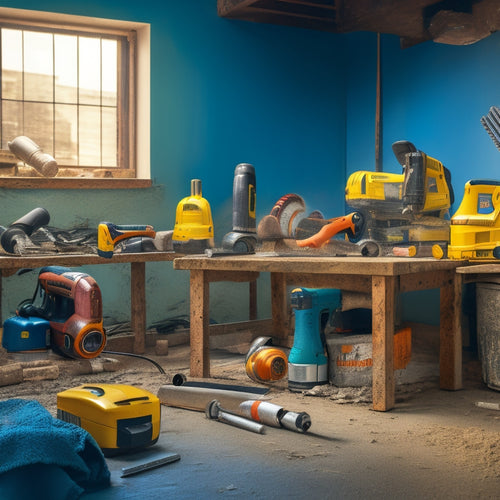
Must-Have Tools for Concrete Patio Projects
Share
When tackling a concrete patio project, you'll need a range of essential tools to guarantee a successful outcome. Safety equipment like goggles, gloves, and dust masks will protect you from hazards. Mixing and measuring tools, including a digital scale and tamping tool, will help you achieve the perfect concrete mix. Concrete finishing equipment, such as trowels and floats, will give your patio a smooth finish. Other must-haves include block laying and leveling tools, edging and jointing tools, surface preparation tools, and compaction and tampering tools. With these tools at your disposal, you'll be well on your way to creating a stunning outdoor space that's both functional and aesthetically pleasing - and that's just the beginning of your concrete patio journey.
Key Takeaways
• Essential safety tools include safety goggles, gloves, dust masks, and steel-toed boots to protect yourself from hazards.
• Mixing and measuring tools like digital scales, mixing buckets, and measuring cups ensure accurate material proportions.
• Concrete finishing equipment, including trowels, edgers, floats, and brooms, help achieve a smooth and textured surface.
• Block laying and leveling tools, such as spirit levels, rubber mallets, and plate compactors, ensure a stable and even foundation.
• Compaction and tampering tools, including shot blasters, floor scrapers, and grinders, prepare the surface for a durable and long-lasting patio.
Safety Essentials for DIYers
Before you begin working on your concrete patio project, regularly inspect your personal protective equipment (PPE) to confirm it's in good condition, as worn-out gear can compromise your safety.
Your safety goggles should have scratch-free lenses and secure, adjustable straps to guarantee a snug fit. Don't overlook the importance of work gloves, which should provide grip, flexibility, and puncture resistance. Look for gloves with reinforced palms and fingers to protect your hands from abrasions and cuts.
In addition to your PPE, make sure you're wearing sturdy, closed-toe shoes or boots with slip-resistant soles to prevent falls. Long-sleeved shirts and pants will also shield your skin from concrete dust and debris.
A dust mask or respirator is also essential for protecting yourself from inhaling airborne particles. By prioritizing your safety, you'll be able to focus on the task at hand and achieve professional-looking results.
Mixing and Measuring Tools
Accurately measure and mix your concrete with the right tools to guarantee a strong, durable patio that will withstand the elements.
You'll need to master mixing techniques that guarantee a consistent blend of cement, aggregate, and water. Measuring accuracy is essential, as even slight variations can affect the concrete's strength and appearance.
To achieve professional-grade results, you'll need the following essential mixing and measuring tools:
-
Digital scale: for precise measurement of cement, sand, and aggregate
-
Mixing bucket: a sturdy, heavy-duty container for combining and blending ingredients
-
Concrete mixer: a powerful tool for thorough and efficient mixing
-
Measuring cups and spoons: for accurate measurement of water and additives
-
Tamping tool: for compacting and leveling the concrete mixture
With these tools, you'll be able to achieve the perfect mix, every time.
Remember, precise measurement and thorough mixing are key to a successful concrete patio project.
Invest in these must-have tools to guarantee a strong, durable, and beautiful patio that will last for years to come.
Concrete Finishing Equipment
With your perfectly mixed concrete in hand, you're ready to shape and refine it into a beautiful patio that showcases your unique style and design sensibilities. This is where concrete finishing equipment comes into play. You'll need the right tools to achieve the desired texture, pattern, and overall aesthetic.
Here are some essential finishing tools you'll need:
| Tool | Description |
|---|---|
| Trowel | Used for spreading and leveling concrete, comes in various types (e.g., V-trowel, fresno trowel) |
| Edger | Creates clean edges and joints, available in manual and powered options |
| Float | Smooths out the concrete surface, removing air pockets and imperfections |
| Broom | Adds texture and pattern to the concrete, choose from various bristle types |
| Finishing Blade | Used for final touches, removing excess material and achieving a smooth finish |
Mastering various finishing techniques, such as floating, tamping, and edging, will help you achieve a professional-looking patio. With these tools and techniques in your arsenal, you'll be able to create a stunning outdoor space that reflects your unique style and design sensibilities.
Block Laying and Leveling
You'll need to lay and level concrete blocks or pavers to create a solid foundation for your patio, guaranteeing a stable and even surface that's both functional and visually appealing. The type of block you choose will depend on your project's specific needs, but popular options include interlocking pavers, concrete retaining wall blocks, and patio stones.
To achieve a professional-looking result, you'll need the right tools for the job. Here are the must-haves for block laying and leveling:
-
A spirit level or laser level to guarantee accurate leveling
-
A rubber mallet or tamping tool to secure blocks in place
-
A screed board or leveling rake to smooth out the sand base
-
A joint spade or trowel to fill gaps and spread sand
-
A plate compactor or hand tamper to compact the soil and prevent settling
Edging and Jointing Tools
Two essential components of a polished concrete patio are crisp edging and well-defined joints, which require a distinct set of tools to execute flawlessly.
You'll need edging tools that can create clean, precise lines and curves, depending on the edging style you're aiming for. For example, a concrete edger or a trowel edger is perfect for creating a decorative edge, while a jointer or a joint cutter is ideal for creating expansion joints.
When it comes to jointing, you'll need to decide on the jointing type that suits your project. Will you opt for contraction joints, expansion joints, or control joints? Regardless of your choice, you'll need a jointing tool that can accurately cut and shape the joints.
A jointer or a joint saw is a must-have for this task. Additionally, consider investing in a joint chisel or a joint cleaner to guarantee the joints are clean and free of debris.
Surface Preparation Tools
Five essential surface preparation tools are required to transform a raw concrete slab into a beautiful, polished patio. You'll need these tools to guarantee a strong bond between the old concrete and the new overlay or coating. Proper surface preparation is critical to prevent delamination, cracks, and other issues that can ruin your patio.
Here are the must-have surface preparation tools:
-
Shot blaster: removes old coatings, dirt, and laitance to expose a solid substrate
-
Floor scraper: removes old adhesives, paint, and other stubborn substances
-
Grinders: smooths out the surface, removing imperfections and creating a uniform finish
-
Vacuum: removes dust and debris to guarantee a clean surface
-
Moisture meter: assesses the substrate's moisture levels to prevent future issues
Compaction and Tampering
As you move forward with your concrete patio project, you'll need to guarantee the soil is stable and compacted to prevent settling or shifting.
You'll want to explore soil stabilization methods that work best for your specific project, considering factors like soil type and moisture levels.
Soil Stabilization Methods
When preparing a concrete patio site, you'll need to make sure the soil is stable and compact to prevent settling or shifting of the concrete, which is where compaction and tampering come into play. Soil stabilization is vital to guarantee a strong and durable concrete patio.
You can achieve soil stabilization through two primary methods: mechanical stabilization and chemical stabilization.
-
Mechanical stabilization involves using heavy machinery to compact the soil, removing any air pockets and increasing the soil's density.
-
Mechanical stabilization can be further divided into static compaction and dynamic compaction, each with its own set of tools and techniques.
-
Chemical stabilization, on the other hand, involves using chemical additives to alter the soil's properties, making it more stable and resistant to water and erosion.
-
You can use chemical stabilizers like lime or cement to improve the soil's cohesion and strength.
Regardless of the method you choose, proper soil stabilization is essential to prevent costly repairs and guarantee a long-lasting concrete patio.
Perfect Finish Techniques
By achieving ideal soil stabilization, you can now focus on perfecting the finish of your concrete patio through compaction and tampering techniques that guarantee a smooth, even surface.
Compaction is essential to remove air pockets and excess water, ensuring a solid foundation. Use a plate compactor or hand tamper to compact the concrete, working in sections to avoid over-compacting.
For a flawless finish, employ smoothing techniques such as tamping, screeding, or floating. These methods help eliminate imperfections, creating a uniform texture.
You can also explore various texture options to add visual interest to your patio. From broom finishes to stamped patterns, the possibilities are endless.
To achieve a high-gloss finish, use a power trowel or apply a concrete sealer.
Cleaning and Protective Gear
You'll regularly need to scrub away stubborn stains and debris from your tools and equipment, making a pressure washer and stiff-bristled brushes essential cleaning tools for your concrete patio project. These tools will help you remove dirt, grime, and old adhesives, guaranteeing your tools are in top condition for the next task.
When it comes to protective gear, don't skimp on quality.
You'll need:
-
Heavy-duty gloves: to protect your hands from harsh chemicals and rough surfaces
-
Safety glasses: to shield your eyes from flying debris and chemical splashes
-
Steel-toed boots: to prevent foot injuries from heavy tools and equipment
-
Breathable, durable clothing: to keep you cool and comfortable while working
-
Respirator mask: to protect yourself from inhaling dust and fumes
Investing in these cleaning supplies and protective clothing will guarantee you're well-equipped to tackle even the toughest concrete patio projects.
Frequently Asked Questions
Can I Use a Regular Drill for Mixing Concrete?
When it comes to mixing concrete, you're likely wondering if a regular drill will cut it.
The answer is, it depends on the drill type and mixing techniques you use.
A standard drill won't provide the necessary torque and speed to effectively mix thick concrete.
You'll need a heavy-duty drill or a dedicated concrete mixer to get the job done efficiently and effectively.
How Do I Prevent Cracks in My Concrete Patio?
Imagine a fragile vase on a wobbly table - one wrong move and it shatters. Similarly, your concrete patio can crack under pressure if you don't take preventive measures.
To avoid this, you'll want to guarantee proper crack prevention techniques, like using control joints and reinforcement materials.
Regular concrete maintenance is also key, including sealing and cleaning.
What Is the Ideal Temperature for Pouring Concrete?
When you're pouring concrete, perfect temperatures are essential.
You'll want to aim for a range of 50°F to 90°F (10°C to 32°C) for best results.
Avoid pouring in extreme temperatures, as this can lead to issues like rapid setting or delayed curing.
Temperature effects on pouring conditions are significant, so make certain you're working within this sweet spot to achieve a strong, durable, and crack-resistant patio that will withstand the test of time.
Can I Use a Pressure Washer to Clean Concrete?
When you're tackling concrete cleaning, you're probably wondering if a pressure washer is the way to go. The answer is yes, but with caution.
A pressure washer's benefits lie in its ability to blast away dirt and grime, but you must use the right concrete cleaning techniques to avoid damaging the surface.
Be sure to use a wide fan tip, keep the nozzle at least 12 inches away, and test the pressure on an inconspicuous area first.
Do I Need to Seal My Concrete Patio After It's Finished?
Coincidentally, you've just finished your concrete patio project, and now you're wondering if sealing is necessary.
The answer is a resounding yes! Sealing your concrete patio offers numerous benefits, including protection from stains, cracks, and fading.
You can choose from various sealing methods, such as acrylic, polyurethane, or epoxy-based sealers, each with its own unique advantages.
Conclusion
You've made it to the finish line of your concrete patio project!
Now, take a step back, admire your handiwork, and give yourself a pat on the back for a job well done.
With these must-have tools, you've transformed a bland outdoor space into a stunning oasis.
Your new patio isn't just a functional area, but a serene retreat that will be the envy of your friends and family.
Related Posts
-

Top Tools for Repairing Cracked Concrete Surfaces
When tackling a cracked concrete surface repair, you'll need the right tools to guarantee a durable fix. Start with e...
-

3 Best Hand Tools for DIY Concrete Construction
When tackling a DIY concrete construction project, you'll need three essential hand tools to achieve a professional-l...
-

Essential Power Tools for Concrete Block Construction
When building with concrete blocks, you'll need a range of power tools to cut, drill, mix, and finish the blocks to g...


